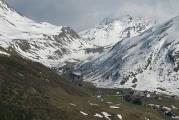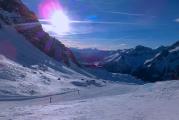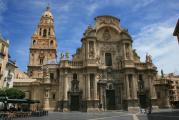Royal Palace. Royal Palace of Turin - Palazzo Reale Royal Palace of Turin Italy
Royal Palace in Turin - one of several royal palaces (Palazzo Reale), built in 1660 on the site of the old episcopal palace, and the former royal residence of the rulers of the Savoy dynasty in Turin until 1865.
Among the architects and sculptors who had a hand in the construction of the palace are the names of Francesco Claudio Beaumon, Daniele Sater, Carlo Dofen, Carlo Andrea van Loo, Giovanni Miel and Gregorio Guilhermi.
The main staircase of the palace was built in the 18th century according to the project of Filippo Juvarra, the famous Italian architect who built the palace of the Duke of Aosta, the Palazzo Birago, the Basilica of Superga, a representative of the late Baroque.
Among the famous attractions of the Palazzo Reale in Turin include the Chinese Cabinet, the magnificently decorated Throne Room and the notorious Scala de Forbici (Staircase of Scissors). In the palace you can see furnishings, tapestries and decorations of the 17th century. The palace chapel is connected by a passage to the Turin Cathedral, where the famous Shroud of Turin is located.
The Royal Palace of Turin is protected by UNESCO as a monument world heritage.
In 2012, the Turin Art Gallery moved to one wing of the palace complex.
Royal Museum of Turin - Photo and video.
Sights of the city Royal Palace of Turin
In the heart of the city on Piazza Castello behind the iron fence, meets us Royal Palace in Turin built in the 17th century, around 1660. Since the palace was to become the official residence Savoyard dynasty it was built by the best craftsmen of that time. The palace survived many different historical periods, including looting by the Napoleonic armies and its closure under seal in 1946 after the fall of the monarchy. Its first "owner" was Carlo Emanuele I and the palace remained residence of monarchs until 1865 before the transfer of the capital Italy from Turin to Florence. Then the palace became available to visitors since those times, but since 2007 The palace is open to visitors as one of the most important. The halls of the palace beckon with their crystal chandeliers, mirrors, mosaic floors, carved and painted coffered ceilings, sumptuous furniture and brilliant decor. Must-sees are Queen's Throne Room, Dining room with fumoire (smoking area) and Daniel Gallery with portraits on display Savoy family.
 The Ballroom, supported by 20 columns, accommodated about 2,000 visitors. From this hall, the passage to the Scissor Stairs Scala delle Forbic i, pictorial creation. Library Biblioteca Reale located in the right wing in the restored rooms in the neoclassical style was installed in 1832 Carl Alberto. More than 180 thousand volumes, 4300 books of manuscripts, parchments, 2000 drawings.
The Ballroom, supported by 20 columns, accommodated about 2,000 visitors. From this hall, the passage to the Scissor Stairs Scala delle Forbic i, pictorial creation. Library Biblioteca Reale located in the right wing in the restored rooms in the neoclassical style was installed in 1832 Carl Alberto. More than 180 thousand volumes, 4300 books of manuscripts, parchments, 2000 drawings.
The basement of the palace is open to visitors royal and giant "cantinoni" cellars. This is one of the most interesting parts for the female half of humanity. But the male half will certainly be interested Armeria Reale opened in 1837 Carlo Alberto and created from exhibits of different origins. The entrance to the chamber is under the arches of the square.
First Sunday of the month entry Royal Palace in Turin free.
Well, let's add that in the New Sleeve of Manica Nuova di Palazzo Reale there is an art gallery La Nuova. Our good advice to you is not to miss it!
Translation of part of the text from Italian by Adriana Cernei for News Events Turin
On the first floor Royal Palace in Turin your eyes will open a salon representing the royal apartments, including the Throne Room, Daniel, royal dining room and a grand ballroom. On the second floor there are thirty rooms, among which are the "Wedding Rooms", which later became the prince's apartments. Umberto of Piedmont. In addition, it is possible to visit royal kitchen in the east wing of the building which was recently reconstructed. royal cuisine connected by a corridor to the Madama Felicita apartment on the ground floor, where you can admire the collection of porcelain and glass, the original table setting has been preserved.
Virtual tour of the Palazzo Reale in Turin.
Benefit from a guide in Turin from News Events Turin
Palazzo Reale - The Royal Palace of Turin, the historical residence of the Savoy dynasty. It was built in the 16th century and later, in the 17th century, modernized by order of Princess Cristina Maria with the participation of the famous Baroque architect Filippo Juvarra. The palace complex also includes the Palazzo Chiablese and a chapel that houses the famous Shroud of Turin. In 1946, the Palazzo Reale became the property of the state, and was turned into a museum. In 1997, the building was included in the list of objects of the World cultural heritage UNESCO along with other 13 residences of the Savoy dynasty.
In 1645, Princess Cristina Maria commissioned the architect Filippo Juvarra to build the palace, which she wanted to turn into a new royal residence. For this, a place was chosen on which the Bishop's Palace already stood, erected in the middle of the 16th century during the reign of Duke Emmanuel Filiberto. The building was located in an open sunny place, moreover, it was not far from other buildings in which the courtyard was going. From the windows of the Bishop's Palace, the duke could see both entrances to Turin - the gates of Porta Palatina and Porta Pretoria. Opposite the palace stood the Palazzo Vecchio and the Palazzo di San Giovanni, sometimes disparagingly called Pasta con Tonino ("Tuna Pasta") because of their architecture, which were later demolished to build the Palazzo Ducale.
In general, the Bishop's Palace was a seat of power and over time was greatly expanded in size in order to accommodate the growing ducal collection of art, hunting trophies, furniture and marble. Emmanuel Filiberto died in 1580, and the palace passed to his son, Charles Emmanuel. In honor of the wedding of his daughters, Margaret and Isabella, in 1608 a portico was added to the building, topped with an open gallery. And in 1630, Victor Amadeus I, who married the French princess Christina Maria, became the duke's heir. It was she who set the tone for the royal court during the reign of her husband. On her initiative, the court moved from the Palazzo Ducale in Turin to the Castello del Valentino, which at that time was located on the outskirts of the city. Many of the children of Victor Amadeus I and Christina Maria were born there. In 1637, after the death of the duke, Christina Maria inherited the reign in the interests of her two young sons.
During the reign of Victor Amadeus II, the Daniel Gallery was built in the Palazzo Reale, named after the artist Daniel Sater, who created the luxurious wall paintings. Also, by order of the duke, a number of summer apartments and winter apartments were built, overlooking the garden. In 1668-1694, a small chapel became part of the Palazzo Reale, which today houses the main religious shrine of the Orthodox world, the Shroud of Turin.
In 1946, the Palazzo Reale was declared the property of the Italian Republic and turned into the Museum of the Savoy dynasty. Its rooms are decorated with rich tapestries and collections of Chinese and Japanese vases. The royal armory, kept in the palace, is a collection of weapons, including rare specimens from the 16th and 17th centuries. Another attraction of the palace is the Scala delle Forbici - a staircase designed by Juvarra. And on the gate you can see the image of the golden Medusa - a symbol that protects against the penetration of spies.
Rivoli Castle is the former residence of the royal house of Savoy in Rivoli (province of Turin, Italy). The castle currently houses a museum. contemporary art"Castello di Rivoli - Museo d" Arte Contemporanea ".

The castle was probably built in the 9th-10th centuries, but its existence was mentioned for the first time only in 1159, in a charter of Emperor Frederick Barbarossa, who ceded Rivoli to the Bishops of Turin.

The Savoy dynasty bought Rivoli in the 11th century, and feuds with the bishops soon broke out, because of which the castle was damaged in 1184. In 1330, Amadeus VI of Savoy moved to the castle of Consiglio dei Principi. The castle was also the site of the first popular veneration of the Shroud of Turin on its way to Turin under Amadeus IX.

After a period of decline, the Peace of Cato-Cambresia (1559) established that Duke Emmanuel Philibert could not reside in Turin until he had a boy.
Therefore, he placed his residence in the Rivoli Castle and began work on its restoration according to the project of the architect Ascanio Vittozzi. In 1562 Charles Emmanuel I was born and he returned to Turin.
The work on the Vittozzi project was completed in 1644 under the direction of Charles and Amedeo di Castellamonto, with the creation of the so-called Long Sleeve (Italian: Manica lunga), intended to house the "Savoy Gallery", the only building of the 17th century that has survived to this day.

However, numerous works of art were stolen by French troops in the following years. New work began after 1706.

Victor Amadeus II commissioned a new façade from Philippe Juvarro, but again it was left unfinished. Victor Amadeus lived here as a prisoner after his abdication and his unsuccessful attempt to restore the reign under his son Charles Emmanuel III. After his death, the castle was abandoned, in 1863 it became a barracks, and twenty years later a part of the building was occupied by a library. The building was badly damaged during the Second World War and it was in this condition until 1979, when new restoration work began. In 1984, the Museum of Modern Art (Italian: Museo di Arte Contemporanea), one of the most famous in Europe, was opened in the castle.
Today, in the restored castle of Rivoli, whose history is rich in fateful fractures and numerous twists and turns, there is a gallery of modern art, most of which is a collection of "arte povero" - poor art. In this case, the exhibited objects are created practically from garbage, because the creators simply have no funds for something else.
 Royal Palace in Turin
Royal Palace in Turin

The Royal Palace of Turin is the main residence of the rulers of the Savoy dynasty in Turin. The Royal Palace in Turin is located on a separate - Royal Square (Piazetta Reale), very close to main square city - Piazza Castello.

It was erected in 1646-1660 at the behest of Maria Christina, widow of Duke Victor Amadeus I.


The famous architects Filippo Juvarra and Guarino Guarini, as well as the lesser-known Benedetto Alfieri, Emilio Stramucci and others took part in its design and construction.






The main staircase of the palace was designed in the 18th century by Filippo Juvarra. The palace chapel is connected by a passage to the Turin Cathedral, where the Shroud of Turin is located. Among other residences of the House of Savoy, the royal palace is under the protection of UNESCO as a World Heritage Site. In 2012, in the classicist wing of the palace complex, in front of which the ruins are visible ancient city, the Turin Art Gallery moved.
Swiss guard hall



Outside, the palace is austere, but inside it shines with blinding luxury and variegated interiors. Especially for this royal residence The chapel of the Holy Shroud was built, in which the famous Shroud of Turin was kept. The Shroud, by the way, belonged to the House of Savoy from 1453 to 1946.

dining room















Today, the rich palace chambers can be viewed. As well as visiting the Museum of Armeria Reale, which is located in one of the wings of the Royal Palace and boasts an interesting collection of weapons and armor.
royal armoury





















In another wing of the palace is the Royal Library, which contains valuable drawings, ancient tomes and manuscripts. Among them stands out the famous self-portrait of Leonardo da Vinci.

Opposite the Royal Palace you can see the famous church of San Lorenzo. It differs in that it has a dome, but no facade - it is replaced by arcades. In the 16th century, two other buildings were located on the site of the current Royal Palace - the Episcopal Palace and the Old Palace, or San Giovanni Palace.
Galleria del Daniel










The project of the new palace was developed in the late 16th - early 17th century by Ascanio Vittozzi. After his death, work on the construction of the Royal Palace was continued under the leadership of Carlo di Castellamonte and his son Amedeo.
Ballroom










Gabinetto cinese









By 1658, the new building was almost ready, and became one of the most important residences of the House of Savoy. In 1668 - 1694, the Holy Shroud Chapel was built in the western wing of the palace, connecting the palace with the Cathedral.
In 1865, the Royal Palace lost its significance - the capital of a united Italy, ruled by representatives of the Savoy dynasty, was moved from Turin, first to Florence, and then to Rome.
Corazzieri Hall




The residence of the king was the Quirinal Palace on the Roman hill of the same name; The Royal Palace in Turin remained only a residence, which the king visited during short visits to his native city. Now there is a museum in the palace.


Three styles coexist perfectly in the architecture of the palace - baroque, rococo and neoclassical. The harmonious baroque façade of the building is over 107 meters long and has an average height of 30 meters.
On the sides of the building there are two pavilions, somewhat rising above the central part of the facade. The symmetry of the palace is interrupted on the left by the spire of the Chapel of the sacred shroud, intended to store the most valuable jewel of the Savoy dynasty. In the interior, the most notable main staircase, designed by Filippo Yuvarra (Scala delle Forbici; 1713), as well as the apartments of the Prince of Piedmont (Appartamenti del Principe di Piemonte) and the Duke of Aosta (Appartamenti del Duca dAosta) on the second floor of the palace.
The architectural picture of the castle is completed by the statues of the Dioscuri (Castor and Pollux), installed in the 19th century on the square in front of the main entrance to the palace. Behind the palace are regular royal gardens(Giardini Reali), created at the end of the 17th century by the famous French landscape architect Andre Le Nôtre. The gardens are equipped with fountains, many sculptures and vases.
Carlo Merlini, Palazzi e Curiosità Storiche di Torino, Torino, Stamperia Rattero.
Vittorio Viale, Mostra del barocco piemontese, Palazzo Madama, Palazzo reale, Palazzina di Caccia di Stupinigi, 1963, Torino.
Umberto Chierici, Torino: il Palazzo Reale, 1969, Fratelli Pozzo Editore, Torino.
Il Palazzo Reale, collana Le grandi Residenze Sabaude, Umberto Allemandi, Torino, 2007.
http://www.cult-turist.ru/place-interes/one-place/521/?q=497&plint=521
http://www.ilpalazzorealeditorino.it/#
https://www.facebook.com/media/set/









